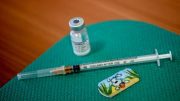Almost every patient with inflammatory bowel disease (IBD) has the same question, and the answer isn’t so straightforward.
“The most frequently requested question following diagnosis is probably, ‘Doctor, what should I eat when living with IBD?’,” says Dr. Maitreyi Raman, an associate professor of medicine at the University of Calgary.
Raman, a gastroenterologist, physician nutrition specialist, and researcher, has done extensive research on the subject and analyzed the existing data regarding dietary patterns that may (or may not) be beneficial to patients.
Crohn’s disease, which can cause inflammation in any section of the digestive tract but most usually affects the small intestine; ulcerative colitis, which affects primarily the large intestine, or colon, and the rectum; and indeterminate colitis, which combines the symptoms of Crohn’s and colitis.
Diarrhea, abdominal cramping and soreness, exhaustion, and unintentional weight loss are among symptoms of IBD.
Patients are generally very motivated to try various therapies that may provide relief, including dietary changes, due to the life-altering nature of the chronic ailment.
“Diet as a risk factor and therapy for IBD has piqued patients’ attention,” adds Raman, who co-authored a study of IBD diets published in Clinical Gastroenterology and Hepatology in March 2021. According to these data, the most well-supported technique is exclusive enteral nutrition, although it isn’t feasible for everyone. Other diets, such as the specific carbohydrate diet, may be beneficial as well.
Regrettably, there is a scarcity of studies on the ideal diet for IBD. Even so, the evidence is mounting. Raman points out that the science and understanding of the gut microbiome, which consists of trillions of bacteria (both beneficial and toxic), has progressed over the last decade.
An imbalance of bacteria in the stomach can lead to a variety of health issues, including IBD. And food can have a significant impact.
According to Raman, recent high-quality randomized controlled trials have indicated that dietary adjustments eased IBD symptoms, reduced intestinal inflammation, and improved patient outcomes.
Before you start thinking about what you can put on your plate and in your body if you have IBD, keep in mind that dietary modifications aren’t a complete replacement for medical treatment.
“Diet is one of several therapy,” says Dr. James Lewis, associate director of the University of Pennsylvania Perelman School of Medicine’s Inflammatory Bowel Diseases Program. “A diet-based therapy may be preferable and realistic for certain people, but it may be far more difficult to adopt for others.”
Certain IBD diets are extremely restrictive, and any significant adjustments in eating habits might be difficult to maintain. Despite this, many individuals with IBD, particularly those with mild to moderate disease, consider nutrition as a treatment option.
Patients should seek professional assistance in developing a specific food plan, according to experts. Dietary decisions must be individualized to the individual, according to Therezia Alchoufete, lead nutritionist for UPMC Total Care at the University of Pittsburgh.
Consider your objectives not simply in terms of IBD, but also in terms of your general health. Also, make sure the focus is on what you can eat rather than what you can’t. Alchoufete encourages patients to make informed decisions while looking for ways to enhance diversity and nutrients.
“For each patient, my goals would be to start creating this positive relationship with food—to truly grasp which foods may make them feel good.”
Only enteral nourishment is provided.
An all-liquid, formula-based meal-replacement diet is the most frequently studied and data-supported diet for IBD—and especially Crohn’s disease. Exclusive enteral feeding is what it’s called, and it’s usually prescribed and managed by doctors.
This is most usually prescribed for youngsters and can be ingested by drinking a specialised formula produced by a doctor or by having a feeding tube put through the patient’s nose and into their stomach.
There’s substantial evidence that it helps patients achieve remission from Crohn’s disease, which means the disease is no longer active. It’s comparable to steroid treatment in helping patients reach remission. It’s also really quick to use. The goal of short-term exclusive enteral feeding programs is to induce remission in six to twelve weeks.
It has, however, mostly been examined in children rather than adults. There’s an even more evident disadvantage: adhering to the diet is difficult “from a quality-of-life aspect, because it means completely removing normal food,” says Dr. Ashwin Ananthakrishnan, a gastroenterologist at Massachusetts General Hospital’s Digestive Healthcare Center.
CD-TREAT
There have been various attempts to use solid foods to imitate the success of exclusive enteral feeding. In a small study published in Gastroenterology in 2019, researchers discovered that consuming an individualized “ordinary food-based” diet with a similar composition to exclusive enteral nutrition, dubbed CD-TREAT, resulted in microbiome changes similar to those seen with exclusive enteral nutrition. In addition, the diet was linked to lower intestinal inflammation and was well tolerated by both children and adults in the study.
A doctor or nutritionist prescribes and personalizes CD-TREAT, which eliminates gluten (thus no wheat), lactose, and alcohol from the diet. It includes all macronutrients (with more protein and fat and fewer carbohydrates) while reducing fiber.
So, for morning, a person might have rice cereal with nondairy full-fat milk, lunch might be grilled cheese on gluten-free toast with an apple, and supper might be grilled salmon with potatoes and sliced cucumber.
The findings provide a framework for treating active Crohn’s disease without relying on a liquid diet, while more research is needed.
Exclusionary diet for Crohn’s disease
The usual red meat-heavy, sugary, processed Western diet that wreaks havoc on gut health is avoided in successful IBD diets. According to research, the move toward that manner of eating is to blame for the rise in IBD rates—even in the East, where the Western diet has been adopted as well, such as Japan.
To combat this, the Crohn’s disease exclusion diet aims to eliminate Western diet mainstays including processed meat, artificial sweeteners, and alcohol, all of which have been shown to negatively impact gut health.
The diet’s effectiveness in easing symptoms and reducing inflammation has been demonstrated in high-quality comparative trials, and it might start working in three to six weeks.
The Crohn’s disease exclusion diet can elicit and maintain remission in children with mild to severe Crohn’s disease, according to a study published in Gastroenterology in 2019.
It was demonstrated to be beneficial for producing and maintaining remission in persons with mild to severe Crohn’s disease in a followup research published in the Lancet Gastroenterology & Hepatology in November 2021.
The Crohn’s disease exclusion diet, on the other hand, is extremely restrictive, as its name implies. For the first six weeks of the 2021 trial, participants were only allowed to eat chicken breast, eggs, and partial enteral nutrition (liquid formula for a portion of their calories) as sources of animal protein, and they were only allowed to eat certain fruits and vegetables.
During the second six-week phase, practically all fruits and vegetables were gradually introduced, although beef and legumes were restricted and one slice of whole-grain bread was allowed daily.
The induction phase, which lasts 12 weeks, is critical for attaining remission. The maintenance phase, which lasts six weeks, reintroduces additional foods to make the diet more sustainable while keeping the outcomes.
Even with those modifications, Dr. Henit Yanai, head of the IBD Center at the Rabin Medical Center in Petah Tikva, Israel, said the diet could be difficult to stick to in the long run and would necessitate in-depth planning as well as home cooking.
a carbohydrate-specific diet
The specific carbohydrate diet, which is a grain-free elimination diet, is based on the theory that eating certain complex carbohydrates feeds undesirable bacteria, resulting in an overpopulation of these “bad” bacteria in the small intestine. Inflammation may result as a result of this.
The diet eliminates everything from table sugar to grains (including wheat and corn), starchy foods like potatoes, and other exclusions based on this notion. However, adherents can eat unprocessed meats, fish, and poultry, as well as fresh or frozen vegetables (but not canned with any additives), and most nuts and oils. Honey can be used as a sweetener as well.
Experts, on the other hand, are concerned about the patients’ capacity to stick to the diet and recommend that the eating plan be closely monitored by a dietician.
Dietary guidelines from the Mediterranean
Some IBD patients are also advised to follow a Mediterranean diet. It’s been thoroughly researched and is widely praised for its numerous health advantages, including heart and brain health.
Best of all, it’s an eating style that’s suitable for almost everyone and is less difficult to stick to than more restrictive diets. You’ll eat a lot of fruits and vegetables, whole grains, nuts, and lean protein like fish if you stick to this diet.
The Mediterranean diet was featured in the DINE-CD study, a rare and prominent head-to-head assessment of diets for IBD headed by Lewis. The study, which was published in the journal Gastroenterology in May 2021, compared it to a low-carbohydrate diet. The study included about 190 patients with mild to moderate Crohn’s disease.
Both diets helped patients reach clinical remission and enhanced their quality of life, according to the study. Both options had no effect on a biomarker used to detect inflammation, which the Crohn’s disease exclusion diet has been shown to help improve.
Lewis and other doctors prefer the Mediterranean approach over the specific carbohydrate diet because it provides for a wider choice of foods and is more investigated for its general health advantages.
Diet low in FODMAPs
The low-FODMAP diet may help patients with Crohn’s disease who are well-controlled in terms of inflammation but still have irritable bowel symptoms. (Fermentable oligo-, di-, monosaccharides, and polyols stand for fermentable oligo-, di-, monosaccharides, and polyols.)
This diet, which is mostly recommended for IBS, tries to exclude short-chain carbohydrates, or sugars, which are poorly absorbed by the small intestine. Wheat, dairy, certain fruits like apples, and vegetables like artichokes and asparagus are first restricted or avoided on this diet.
“I might try the FODMAP exclusion diet if they have substantial pain and bloating and nothing else is working,” says Dr. Jean Fox, a gastroenterologist at Mayo Clinic in Rochester, Minn. However, she usually has patients follow the strategy under the supervision of a dietician, so the restrictive period doesn’t last longer than six weeks.
Following that, meals are gradually reintroduced over six to eight weeks in the reintroduction phase to see which ones are creating problems. After determining which foods are likely to produce symptoms, such foods can be avoided or limited.
The disadvantage, according to Fox, is that individuals who don’t observe any symptom improvement after following this diet may be restricting meals unnecessarily.
TIME’s Other Must-Read Articles





